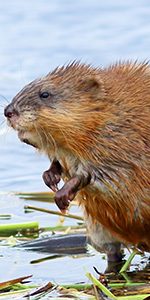| Muskrat | ||
 |
Classification(s) : | Prey |
| Cat Name : | Muskrat | |
| Common Name : | Muskrat | |
| Scientific Name : | Ondatra zibethicus | |
| Other Name(s) : | ||
| Physical Description : | Semi-aquatic rodents named after their prominant odor. |
|
| Physical Statistics : | Length: 16 – 24 Inches (41 – 62 Centimeters) |
|
| Behavior : | Muskrats build nests in the middle of lakes or ponds similar to beaver lodges. They are active at dawn and dusk and feed on aquatic vegetation, as well as occasional shellfish, frogs, and fish. |
|
| Social Organization : | Muskrats live in family groups, usually with a mating pair and their young. |
|
| Approval Level : | None; Muskrats are not rare creatures, but they are larger than the average rodent, and their habitat in water could cause more dramatic roleplay than simply hunting a land mouse. | |
| Kill Difficulty : | Low; Despite their size, muskrats are still no match when compared to cats and have very little adaptions to defend themselves. |
|
| Training Level : | Specialty - Group Land; Since muskrats spend a lot of their time in water, warriors are at risk of drowning if they try to hunt one. |
|
| Hunting Tactic : | Waterside Rodents | |
| Food Quality : | High; Muskrats possess a large amount of tasty, nutricious meat. | |
